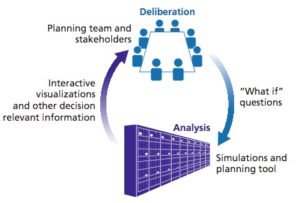RAND and Lawrence Livermore National Lab Combine High Performance Computing and Public Policy Analysis for Demonstration of Water Resource Management

Researchers from the RAND Corporation and the Lawrence Livermore National Laboratory have joined forces to combine high-performance computing with innovative public policy analysis to improve planning for particularly complex issues such as water resource management.
Building on previous work conducted by RAND on the Colorado River Basin in 2012, RAND and the High Performance Computing Innovation Center at Lawrence Livermore National Lab hosted a joint workshop to employ high-performance computer simulations to stress-test several water management strategies over a vast number of plausible future scenarios in near real time.
The “deliberation-with-analysis” method – a process by which stakeholders come together with experts to evaluate a complex problem and alternative solutions in a scientifically rigorous manner – provides detailed options. But this method can take weeks to obtain results, thereby slowing down the decision-making process. By using supercomputer simulations, the participants were able to customize and speed up the analysis guiding the deliberations of decision makers.
“In the latest workshop we performed and evaluated about 60,000 simulations over lunch. What would have taken about 14 days of continuous computations in 2012 was completed in 45 mins–about 500 times faster,” said Ed Balkovich, senior information scientist at the RAND Corporation, a nonprofit research organization.
With growing demand and a changing climate, the Colorado River Basin is under significant stress. The river supplies water to 30 million people in seven states, supports billions of dollars in economic activity each year, and irrigates 15 percent of all U.S. crops. It also provides water to 22 Native American tribes, four national recreation areas, and 11 national parks.
The workshop tested five different water management portfolios such as conservation, groundwater and seawater desalination, and water reuse, against thousands of scenarios reflecting uncertainty about future climate change and development patterns.
Many of the participants involved in the 2012 study, including U.S. Bureau of Reclamation and Colorado River Basin officials, attended the workshop along with others interested in how supercomputing can advance the state-of-the-art in quantitative decision support.
“This workshop showed how RAND’s innovative analytics methods supported by Lawrence Livermore National Lab’s advanced computing capabilities can accelerate decision and policymaking on one of the critical issues of our time – water management,” said Fred Streitz, director of the High Performance Computing Innovation Center. “These same methods and resources can improve the decision making process for a broad spectrum of national and corporate challenges.”
The demonstration was a result of the Lawrence Livermore National Lab/RAND Partnership for Computational Policy Analysis. Between RAND and the High Performance Computing Innovation Center at Lawrence Livermore National Lab, this partnership pairs advanced computing with innovative analytic methods to address complex public policy and national security challenges
A summary of the workshop highlights results, benefits, and challenges associated with using advanced computing in this context. The report, “Using High-Performance Computing to Support Water Resource Planning: A Workshop Demonstration of Real-Time Analytic Facilitation for the Colorado River Basin,” can be found at www.rand.org.


